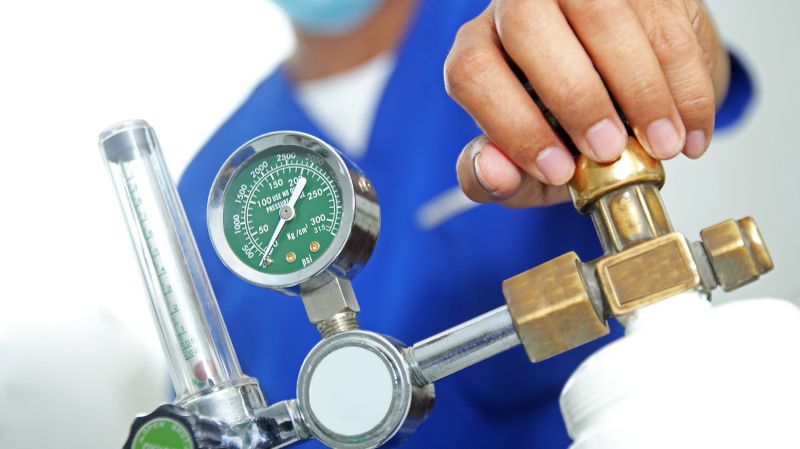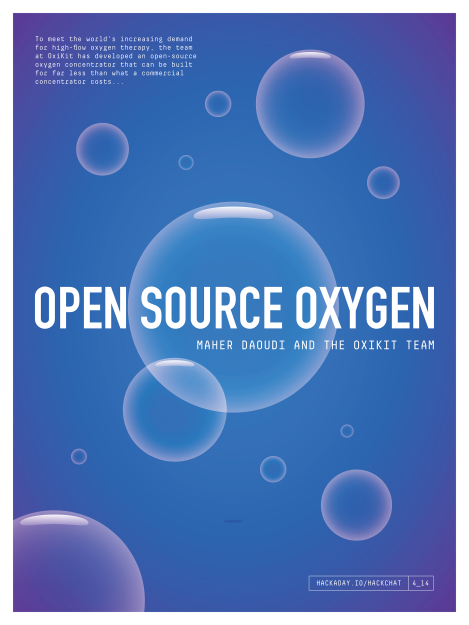Join us on Wednesday, May 5 at noon Pacific for the Open-Source Oxygen Hack Chat with Maher Daoudi and the OxiKit Team!
In such tumultuous times, it may be hard to remember last week, let alone last year. But if you dig back a bit, you may recall what a panic the world was in at this point in 2020 about the ventilator crisis. With COVID-19 cases on the rise and the potential for great numbers of patients needing intensive care, everyone and their brother was hacking together makeshift ventilators, in the well-intentioned belief that their inventions would help relieve the coming shortage of these lifesaving medical mechanical miracles.
As it came to pass, though, more COVID-19 patients have benefited from high-flow oxygen therapy than from mechanical ventilation. That’s great news in places where medical oxygen is cheap and easily available, but that’s always the case. We’ve seen recent reports of hospitals in India running out of oxygen, and even rural and remote areas of the developed world can find themselves caught without enough of the vital gas.
To meet the world’s increasing demand for high-flow oxygen therapy, the team at OxiKit has developed an open-source oxygen concentrator that can be built for far less than what commercial concentrators cost. By filtering the nitrogen out of the air, the concentrator provides oxygen at 90% or higher purity, at a flow of up to 25 liters per minute.
Oxikit founder Maher Daoudi and some of the technical team will join us for this Hack Chat to discuss the details of making oxygen concentrators. We’ll learn about how they work, what the design process for their current concentrator was like, and how they got past the obstacles and delivered on the promise of high-flow oxygen for the masses.
 Our Hack Chats are live community events in the Hackaday.io Hack Chat group messaging. This week we’ll be sitting down on Wednesday, May 5 at 12:00 PM Pacific time. If time zones have you tied up, we have a handy time zone converter.
Our Hack Chats are live community events in the Hackaday.io Hack Chat group messaging. This week we’ll be sitting down on Wednesday, May 5 at 12:00 PM Pacific time. If time zones have you tied up, we have a handy time zone converter.
Click that speech bubble to the right, and you’ll be taken directly to the Hack Chat group on Hackaday.io. You don’t have to wait until Wednesday; join whenever you want and you can see what the community is talking about.

















The “HIPAA Sanitary Air Filter” is interesting.
I’m more interested in how this is going to save ‘Trillions of lives’
You have to imagine that being said by a “Serial Entrepreneur” named “Robert Danger Byrd”.
I’m about to start a project that pipes oxygen into a reaction setup (that I built), and I’d like to learn the fundamentals of oxygen hacking. I hear that “The Oxygen Hacker’s Companion” is the go-to reference for this, but the book is no longer purchasable (sent a check awhile ago, no response) and it’s not available anywhere.
Does anyone have a good source for learning about oxygen plumbing from the ground up? Something not sky-high technical, but full of down-to-earth suggestions and examples, sort of like the Radio Amateur’s Handbook, but for gas plumbing?
(Alternately – is anyone willing to send me a photocopy of the Oxygen Hacker’s companion? I’d be happy to pay copier fees and postage, and I’ve already sent a check to the author. Contact me on .IO if interested https://hackaday.io/PWalsh)
#1 thing is absolutely no oil anywhere that the concentrated oxygen will contact. Think of the conditions that caused the Apollo 1 fire. Fuel + O2 + any ignition source.
Also ignition source can be just about anything and almost anything burns in O2. http://www.spacesafetymagazine.com/aerospace-engineering/space-suit-design/spacesuit-fire-nasa-refuses-forget/
While the general rule is true, they’re oxygen-compatible oils, lubes and greases. Equally important is to clean everything meticulously before exposing it to high pressure oxygen
Worth pointing out that HFO2 has strained our ability to deliver oxygen in the first world too.
From the heat exchangers on the oxygen evaporators freezing to the pipelines causing the gas pressure equivalent of ‘voltage sag’, it hsan’t been easy here either.
Prior to ‘high flow’ being a thing, the largest oxygen flow rates you might encounter for a sick patient was 15LPM O2.
Since high flow O2 arrived, this has gone up to 50/60L flow (worst case pure O2, but even at say, 50%, still a large flow increase compared to before). Also, on a ward, it would be unusual to run 15LPM flows for a prolonged time, as these patients were often destined for a move to ICU. However, with high flow O2, having bays (6 patients) on, say 50% O2 50L flows (so 25LPM flow per patient) wasn’t uncommon, which the infrastructure simply wasnt designed to handle.
@David Pye: What is the HFO2 that you are referring to?
An exotic Zeolite or maybe you’re referring to a refrigerant?
I’m not very familiar with either from a chemistry perspective in exact detail. However, each topic… especially Zeolites seems like an area of opportunity for significant future research and application.
I think, he means HFO2 = high flow O2. It’s apparently a medical procedure “High flow oxygen therapy”.
@Iluki: Appreciate that. Never dealt with high flow oxygen and my brain compartmentalized chemistry formulas.
Thought about buying an oxygen generator last year as for the obvious global reason, had low blood oxygen for ages. Not fun and lost a job because of it. Hurrah for the startup not dealing with health issues properly and being deeply silly instead. Still not back to square 1, but much better.
Point being, while I probably should have purchased one and had a better time of it, now I don’t think I need it. But to build one. Sounds fun and perhaps useful too.
People need to learn about oxygen safety before they go playing around. Industry standard is anything over 23.5% is considered oxygen enriched and should be treated as such. All piping, instrumentation, regulators, etc should be ‘oxygen cleaned’ using IPA or an oxygen compatible cleaner and then black lighted to ensure all traces of hydrocarbons have been removed. Any remaining hydrocarbons can provide ample fuel for a fire only requiring a spark.
People get surprised by what will burn when you enrich it with oxygen. I work at an air separation plant and we couldn’t even use asphalt for the drive ways in the process areas.
Reading the detailed postmortem on the Apollo 1 fire is enlightening, too. Stuff that’s not normally considered flammable can be quite flammable, and stuff that’s normally “merely flammable” can become nearly explosive.
Non-flammable? Challenge accepted.
I’d prefer an ESB instead of an IPA….
If you search “zeolite contamination during PSA oxygen concentration” you’ll find one of the Achilles’ heels of this type of concentration – other gasses/vapors. This has been kind of a stumbling block since the original patents of the 1960s (US4477264A is a good start).
The Zeolite has to be regenerated by heating periodically and some of the contaminants such as NO, NO2 and SO2 are more tenacious than others.
Reading into recently, something that came to mind was the Cold Storage reduced oxygen atmosphere operations and other food preservation methods as a potential source for two goals with already practical applications:
1. Oxygen Sourcing
2. Carbon Sequestering
Bonus Revenue Streams Potential: More Guinness and other Nitrogenated stouts and products.
Hello, Typo Man here.
I think that:
“[…]That’s great news in places where medical oxygen is cheap and easily available, but that’s always the case.[…]”
ought to be:
“[…]That’s great news in places where medical oxygen is cheap and easily available, but that’s _not_ always the case.[…]”
…
Typo Man, away!!!
where did they get the o2 for their steel industry?
This is amazing. I am a 75 and had a head injury as a child that only responds to O2 so I can go into REAM sleep. For the last few years our local supplier insists O2 an concentrator is all I need. I am a retired nurse and know that is not true, and I have not gone into REAM sleep since I lost the O2. This work could save millions of lives during the pandemic.
As a retired nurse you might check on REAM sleep. Do you perhaps mean REM sleep? as for “is a concentrator less effective than bottled oxygen?” Nope, FIO2 is the same in each. Typical 10LPM concentrator will deliver an FIO2 of >0.9. More than adequate unless you’re looking at hyperbaric oxygen therapy… in which case a concentrator would actually be my preferred choice…